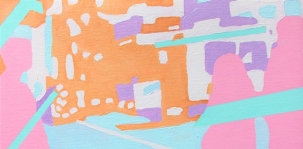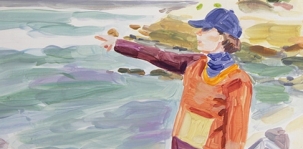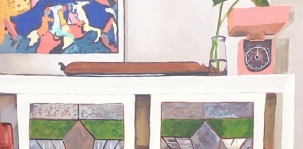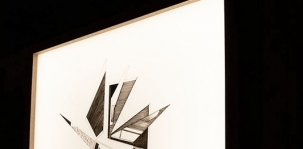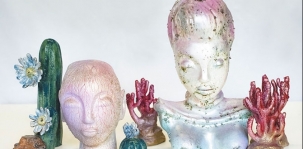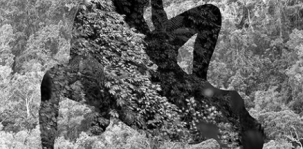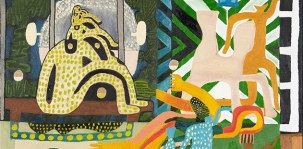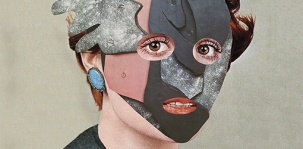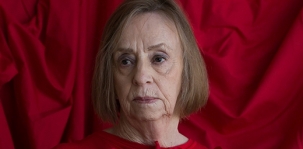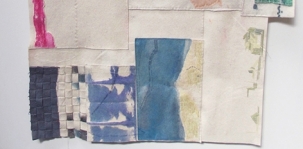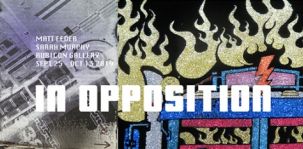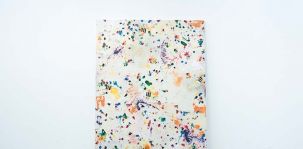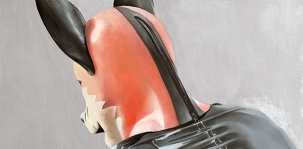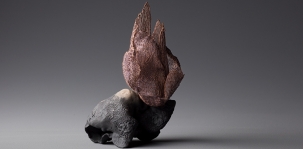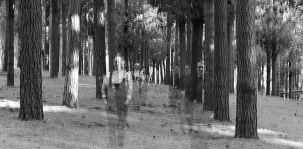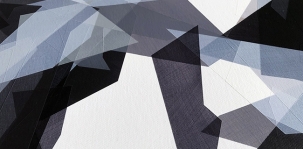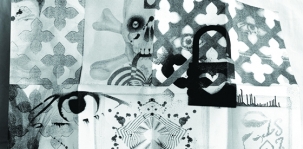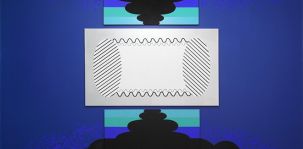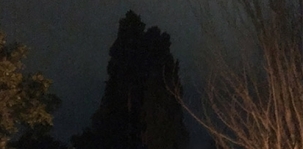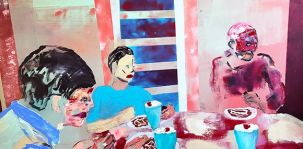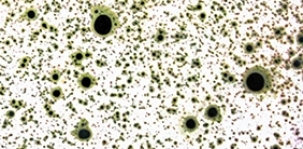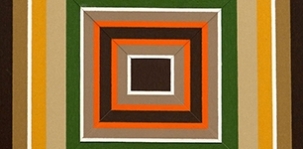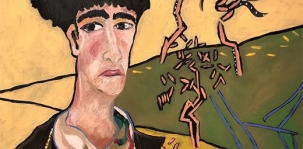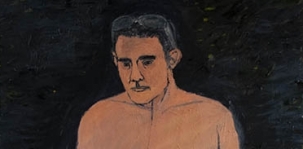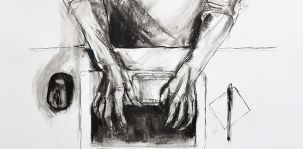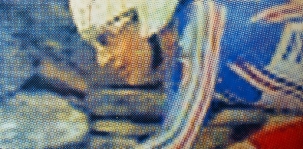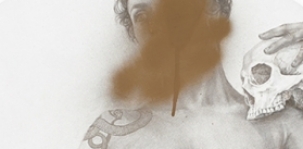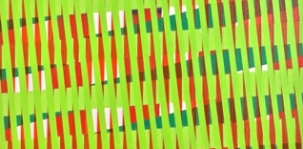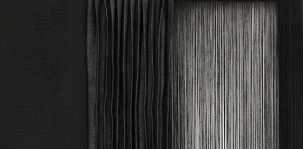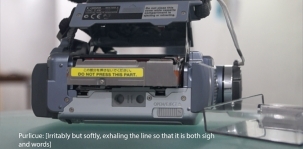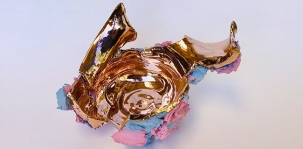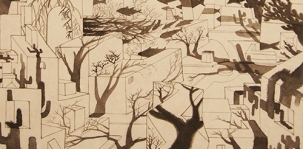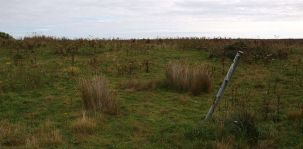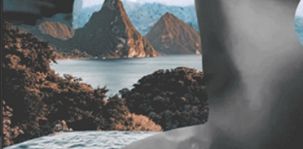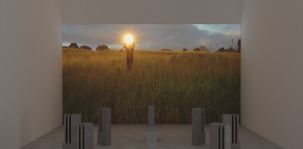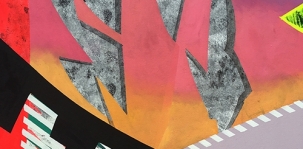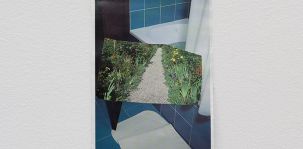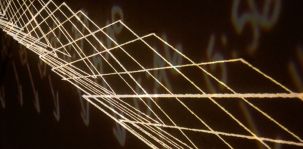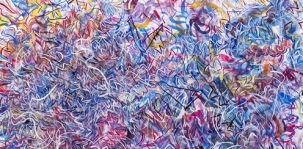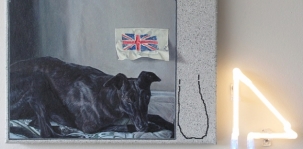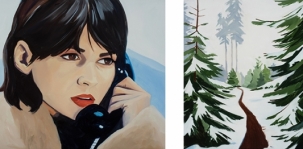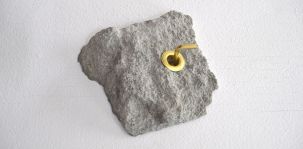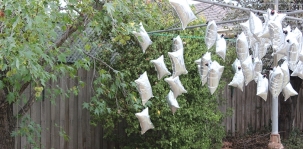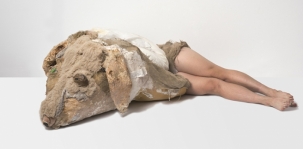Archive : 2019
November 27 - December 14, 2019
Ysabelle Ruddle
Makeshift explores the continuum of the ever-changing spaces we live in. The paintings reflect spaces at various stages: new, old, renovated, upgraded, and experienced or yet to be experienced as well as spaces that act as a temporary measure. The dynamic nature of spaces arranged and rearranged, aimed to be functional and to serve the human need. Through layers of paint, traces or shapes that reflect the environment, I aim to emulate one’s experience of space, an experience of space that is frequently makeshift or impermanent.
Lucy Fahey
Some Things Have Changed is a collection of paintings about a family’s grief. In secular Australia, we are quick to bury our dead and return to daily life. We have forgone many of the rites and rituals around death embraced by generations past, and we feel uncomfortable when we see someone grieving publicly. The portraits in the collection depict moments in the lead up and aftermath of my father’s death. They capture moments of change that are both small and momentous. In Mum’s Gone Blonde, the couch my mother sits on is the first piece of furniture moved in the family house since my father’s death. The paintings are both reflective and hopeful: they acknowledge the glacial work of mourning and the permanence of a family member lost, but they also capture moments of strength and resilience.
Lucy Fahey is a painter, illustrator and animator living and working in Melbourne. Her work investigates issues of identity, selfhood and family life. Since graduating from RMIT University in 2009, Lucy has exhibited in gallery spaces in Melbourne and created commercial work on commission for public institutions and private clients. Her work has been acquired by the State Library of Victoria and Museum Victoria. In 2019, Lucy’s paintings were shortlisted for the Ravenswood Art Prize and the Milburn Art Prize. She was awarded an ArtStart grant by the Australian Council and in 2010 and a creative fellowship by the State Library of Victoria in 2011
Margaret McIntosh & Jade Piltz
We met at art school when we were 17. This exhibition Spare Room explores ideas of change both within relationship and the painting process. Making paintings in home studios has connected our interest in the domestic experience. The notion of making a mess and cleaning up again mimics applying layers of paint in a search for tension as well as spontaneity. This collaboration also looks at the dynamics of female friendship through the evolution of our personal relationship; a shared dialogue of empathy, concern, caution, boundary and adoration of each other and painting over fifteen years. Margaret works from her home studio that is a bungalow out the back of her house in Reservoir. She holds a Masters in Art Therapy from Latrobe University. Margaret is interested in our familiar relationships with particular objects and spaces; how moving across and between different landscapes we use particular associations to form connections. Our feeling of belonging resonates in memory.
Jade works from a home studio which she shares with her two young daughters. The constant chaos of the space works as source material for her paintings. Jade applies layers of colour, shape and line, each layer informing the next. Working on a group of paintings at one time, she moves between each one in a constant state of unknowing until each painting is resolved. Jade’s work celebrates the magic of mark making and explores her ever-changing relationship to painting amidst the landscape of domestic life.
November 6 - November 23, 2019
Della Butler
The plan... it all begins with that. Then expectation. Then execution. Then the photograph. The moment is captured. There is no going back now. Taking reference from personal photographs, Can’t we just be spontaneous? explores the nature of memories and the way that they can be re-contextualised and re-informed. Rendering snapshots in time, Butler’s drawings question the way that moments are portrayed and the fractured recollections of what we see versus what we remember. Through her latest body of work she explores the mundane, the interesting and the forgotten, all the time questioning whether we can ever break away from a singular lived moment.
Working across drawing and collage, Della Butler’s practice is informed by personal experience and family history. She completed a Bachelor of Fine Art at Monash University in 2014 and a Masters of Art (Arts Management) with Distinction at RMIT University in 2016.
Natalie Papak
Night Garden’ presents mixed-media works on paper, canvas and wood alongside sculptural ceramics that are installed to emphasise spatial play; encouraging a navigation of the gallery that is immersive.
The conceptual basis of the project is inspired by organic processes that occur by the light of the moon and during sleep that are both transformative and regenerative for humans and the natural world alike. By drawing attention to the magic and mystery of natural laws that humans appear to have lost contact with, ‘Night Garden’ invites the viewer to undergo an experience wherein reflection upon the roles of a range of organisms within these cycles is acknowledged, illuminated and embraced.
Natalie Papak is a visual artist & art educator born and working in Melbourne. Recent solo exhibitions include ‘Traversing the Void’ (2016) at Seventh Gallery, and ‘Nascent Desire & Captivating Narcissism’ (2013) at BLINDSIDE gallery. A notable career highlight was her artist residency in the the historic town of Vallauris in the South of France, in 2014 where she worked alongside a group of peers to create and exhibit an individually proposed body of work.Her educational background includes a Bachelor of Fine Art in Painting and a Post-Graduate Diploma of Visual Art, both completed at the Victorian College of the Arts in Melbourne. Her Graduate Diploma of Teaching was completed in 2003 at Melbourne University. Natalie has been exhibiting her work professionally in a range of contexts since 1997, her first solo exhibit was held at the George Paton Gallery, Melbourne University in 1999.
Karla Pringle
Bodies, trauma, instinct, nature, affect, cycles, patterns, bacterial intelligence, love and symbiosis. I work to reconcile my complex history with my environment. These banners are love poems between body and Country. Some are intimate poems of bodies reclaiming their animism via symbiosis with nature, and larger body/land sized works using sensorimotor mark making while deeply listening to Country. I try to be receptive to my carnal relationship with my environment, our mutualism, our history, and the slow process of reconciling our union.
Karla Pringle lives and works on Kabi Kabi/ Gubbi Gubbi County and acknowledges and pays love and respect to elders past, present and emerging.
October 16 - November 2, 2019
Max Callaghan
We rarely speak honestly and specifically about mental illness and its treatment. Running into a Carpark Naked is a group of paintings and drawings that show and speak about personal memories from a 2 month period of time spent in an open ward, locked ward and seclusion room of a psychiatric hospital in South Australia, Five years ago.
Max Callaghan is a visual artist from Adelaide. In 2017 he graduated with BVA Honours (First Class) from Adelaide Central School of Art and in 2018 he held his first solo exhibition at FELTspace in Adelaide. He is currently undertaking a 1-year studio residency at ACE Open in Adelaide.
Aylsa McHugh
Aylsa McHugh lives and works in Melbourne, Australia. In 2002 she graduated with a Bachelor of Fine Arts in Sculpture from the Victorian College of the Arts, University of Melbourne. Aylsa’s most recent practice sees her utilising collage, appropriating images found in magazines and books. She is particularly focussed in the multitude of ways environmental narratives inform and colour our individual and collective psyches. Aylsa's debut solo exhibition Persona is the result of her ongoing investigations into marrying seemingly heterogeneous subject matter to create new and divergent readings. She is interested in how the recontextualizing and combining of found imagery can convey the uncanny. Persona is a series of paired images of vintage hair models with sculptures from the modernist period which enact simultaneously unsettling and elegant juxtapositions. These assemblages are compelling and perverse, disjointed yet harmonious, a celebration of the arcane and strangely beautiful. Aylsa would like to respectfully acknowledge the Traditional Custodians of the land on which she is exhibiting, the Wurundjeri peoples of the Woi Wurrung language group. She would also like to acknowledge that the Wurundjeri people have never ceded these lands and have been caring for and living on Country, making and creating here, for many, many thousands of generations. She honours their Ancestors, Elders and next generations of community.
Ilona Nelson
“As photographs give people an imaginary possession of a past that is unreal, they also help people to take possession of space in which they are insecure.” Susan Sontag.
Enjoy Your Rebirth invites you to find peace within your past and courage to step onwards. A solo exhibition by Ilona Nelson featuring performance, photography, film and installation, also included is The Worry Cloak made from anonymous worry donations. Within the exhibition you are invited to gently place your hand on the cloak and energetically release your worries into it, the cloak will be burnt post show.
September 25 - October 12, 2019
Deb K Williams
Slow Territory responds to the connection between stitching, weaving and drawing and the contemplative, meditative nature of these activities. Using natural dyes, inks and acrylic and collaged felt, silk and cotton, the works respond to a range of natural processes such as the cycle of rehydration and evaporation found within salt lakes, tidal drawings of bush fire ash on coastal areas and verdant growth on lava rocks. Notions of distilling an atmosphere of place are explored and the works form a map of remembrance and meditative intent.
Deb K Williams has exhibited widely and is currently interested in creating works that explore traditional making methods and how these are linked to place and memory.
Sarah Murphy & Matt Feder
In Opposition is an investigation into the significance of a process based technique that connects to industry, and class. Sarah Murphy and Matt Feder's works are bound in their semiotic usage of transport imagery, and what it is to move, or be moved from one place to another. To merge, and simultaneously expose the differences between two separate works dealing with: the value of the artists hand, materiality and the binary of high and low art, questioning what it is for the masculine, or feminine to build/construct an atypical object or environment.
Sean McDowell
The exhibition brings together a suite of paintings created over the last two years, which continue the artists’ exploration into materiality, process and ideologies of display. The work follows a trajectory that merges instinctive markings with formulated systems, in which theapplication of paint shifts dramatically from scarce areas of bare canvas to dense clusters of ordered patterns and haphazard gestures. The surface transforming from translucent washes to thick, textured dots and lines applied directly from the tube; each behaving differently in their articulation of a performative action.
Sean McDowell is a German born, Melbourne based artist whose practice spans sculpture, painting and installation. In 2018, he graduated with a Bachelor of Fine Art (Sculpture and Spatial Practice) from The Victorian College of the Arts, where he was the recipient of the Perrin Sculpture Foundry Award. Recent solo exhibitions include Cuprum, Cuprum, Kings Artist Run and The Repositioning of Objects that Once Functioned, George Paton Gallery. McDowell has also been involved in group exhibitions including Extended Gestures Extended, Five Walls Projects and The 2019 Keith and Elisabeth Travelling Fellowship, Margaret Lawrence Gallery. His work is held in various private collections in Australia, Germany and The Netherlands.
September 11 - September 21, 2019
Christian Moes
Emergence is the process of becoming. Beings of the in-between, these manifestations represent a turbulence in the natural world that has succumb to human consumption and disregard. They emerge from the depths of moral pollution and crawl upon the wasteland of our mortality. Slowly becoming a mark of death and decay, these are the spirits of our unbecoming.
Christiaan Moes is an emerging Melbourne artist whose work revolves around the subject of anthropomorphism (the attribution of human characteristics to animals) using it as a metaphor and visual embodiment for the human condition, critiquing social identity, sexuality and perception of nature.
Michaela Pegum, Inari Kiuru, Lauralai Wilson, Aurelia Yeomans
The artists in Earth bound, light bound share a deep interest in the rich and mercurial paradigm that encompasses our connection with the earth and its atmospheres. Their works include both wearable and sculptural forms and are the result of close observations of the shared space of natural phenomena and emotions.
Physical and ephemeral elements of our relationship with the natural world are channeled through sensitive transformations of materials that include metals, minerals, textiles and ceramics; speaking in languages that resonate internally and externally, referencing the landscape, the body and the psyche and the symmetries and tensions between them.
Claire McArdle , Zoe Brand
The idea of the multiple is a popular staple of the art world. Editions of prints or photographs are prevalent and even the three dimensional object has been adapted to this model. The work of Joseph Beuys shows the breath of the multiple from signing and writing slogans on bank notes (often Kúnst=Kapital) to Sled (1969).
Brand and McArdle seek to explore the idea of the multiple through their existing practices. How can this notion be the central force for making? What is a multiple? How do their practices play differently off this central theme?
August 14 - August 31, 2019
James Little
A series of landscape paintings inspired by Tarra-Bulga National Park, Victoria.
https://www.james-little.com/
Peter Leigh
These works form part of an ongoing investigation into the nature of information and how it is generated, distributed and fragmented. Each work is produced according to the same set of constraints, using the same set of fragmented information generated from found imagery. Through this process the found images are separated from their original content and used instead as a means of exploring the various tensions inherent in painting; rigid structure and improvisation; flatness and depth; the mechanical and the handmade; movement and stillness; durations of time; seriality and variation. The formats of these works also reference common display resolutions of screens through which we are exposed to a perpetual stream of information. The found images used to create this series of artworks were taken from the top ten Google search trends for 2018.
Michael McKenzie
Michael’s work is drawn from both a personal and universal psychological connection. The exploration of trying to exist in a pre-existing social establishment where not all true desires can be met. Feelings of guilt and a perverse nature can happen when the ‘real world’ or civilisation deprives you of the freedom of truly discovering ones self. The obsession with becoming famous or wanting to be loved for a sense of worth in a society set up for hierarchy. The use of alternative methods with accessible objects as an escape if it can’t be achieved that can result in a distorted identification. This visually documented psycho-analysis manifested inevitably takes form of illustrated alter egos that don’t physically exist. Or do They? 2 conflicting forces of masculinity and femininity, conscious and unconscious, creation and destruction, life and death all interconnected. Further unlocked unconscious thoughts, feelings and word associations are communicated with iconography, design and illustration. This is as a result of a filtered perception and reinterpretation of an overwhelming multi-media and pop culture world we
have grown up in.
July 24 - August 10, 2019
Amina McConvell
A Combinatorial Explosion is an installation and mural work which looks at exponential, cascading chain reactions that occur in nuclear explosions. Within the context of this body of work, these chain reactions function as a signifier of a potential global catastrophe; whereby growth occurs too rapidly and decay soon follows. The artist uses geometric conceptualism and abstract forms to convey the stages of the nuclear reaction. The diagrammatic forms are used to create a progressive abstract composition, within which, one form triggers another, and then another, and another in progression.
This project is proudly supported by the Australia Council for The Arts and Arts NT.
Nada Polski, Fleur Summers, James Healey, Henry Law, David Dellafiora, Susan Hartigan, Gracie Edwards, Richard Harding, Peter Ellis, Chris Deakin, Louise Weaver, Shaun Wilson, Tammy Honey, Michael Vale, Adam Lee, Greg Moncrieff, Fran Van Riemsdyk, Craig Easton, Simon Perry, Joyce Huang, David Thomas, Cat Polski, Adrian De Vries, Shane Hulbert, Tammy Hulbert, James Murnane, Jim Murnane, Kit Wise, Elouise Harper, Bronte Webster, Wilma Tabacco, Charles O’Loughlin, Peter Clarke, Colleen Morris, Peter Hill, David Thomson, Lesley Duxbury, John de la Roche, Lesley O’Gorman, Greg & Davis Fullerton, Kevin White, Max White, Tiffany Parbs, Ron Guy, Kristian Brennan, Ceri Hann, Jason Wade, Benjamin Sheppard, Rhett D’Costa, P J Hickman, Robin Kingston, Harry Hay, Simon Gardam, Paul Compton, Morris Edwards, Malcom Bywaters, Julian Goddard, Ben Harper, Rod Prohasky , Al Outchomsky, Rhonda Watson, John MacKinnon, Stephanie Kam, Gabriel Nielsen, Gracia Haby, Louise Jennison, Jim Ross, Guy Hughes, Raphael Buttonshaw, Nicholas Jones, Enrique Toches, Adam Lee, Andrew Tetzlaff, Tony Garifalakis, Stephen Armstrong, Katie Paine, Andrew Gunnell, Maria Quaremba and others
The Museum of Platitudes and Aphorisms project is a series of exhibitions and events that explore how individual artists and audiences explore their thinking about the presence of art in a studio or a gallery environment. It seems that there is a peripheral vision that occurs in all artist’s practices which, once recognised, either avoids or extends the awareness of the role of art and galleries in our lives. The aim of the project is to ask both makers and observers to reflect upon their own values in the experiences of making, encountering and looking at art. The role of the museum or gallery as the psychological architecture used to reflect upon accepted knowledge is also in review.
Felix Atkinson
Soft trees break the fall is the latest body of work from Naarm-based artist, Felix Atkinson. Made over a period of great uncertainty snd instability, this body of work reflects the artists’ concerns with vulnerability, intimacy, trauma and memory Read together with the title of the exhibition, the paintings carry within them the bittersweet realisation of the ephemeral nature of all things.
July 3 - July 20, 2019
Noah Spivak
Thousand Tears investigates the study of visual re-presentation and its ability to create distance between idea (memory) and object (self). Spivak isolates, breaks and reconstitutes the materials inherent to photography allowing the medium an opportunity to look back on itself. This exhibition serves as a reminder of the physical and chemical processes of photography, granting the viewer space to consider the value of image in our visually saturated culture.
Noah Spivak studied at the Cooper Union School of Art, New York and received a Bachelor of Fine Art in photography from Emily Carr University of Art and Design, Vancouver in 2015. Shortly after graduation he migrated to Melbourne and has been actively producing since in his Brunswick based studio. Spivak has exhibited both nationally and internationally.
Patrick Heath
Patrick Heath is an emerging artist from Adelaide. His work uses found materials and pop cultural artifacts to explore overlapping personal and social narratives, playing with myth, nostalgia and the vernacular culture of suburban Australia. Standing On The Outside...New work representing the artist’smusings on repetition, nostalgia and the intimacy of the ubiquitous. These altered, found canvases explore ideas of home and the fractured nature of memory through histories encoded within patterns.
This exhibition is supported by the Helpmann Academy
Thomas Kuss
Why do I feel so much ?
Why do I fear so much ?
Why do I judge ?
Why do I assume ?
Why do I compare ?
Why do I have guilt ?
How do I comprehend the past ?
Why do I want to know ?
Why is it best not to know ?
Do I need to change ?
Do I need to grow ?
Do I need to compromise ?
Do I need help ?
Do I need you ?
June 12 - June 29, 2019
James Grant
Portraits between Alice Springs and Darwin presents a collection of figures drawn from my childhood memories of farmers and stockmen while traveling in this region. Executed on several large scale canvases the characters depicted here explore ideas of masculinity, isolation, fragility and the development of identity. I hoped to respectfully portray people whose perceptions of the world and their environment differ from those held by many urban Australians.
Rachel Gresswell
Working for two minutes takes its cue from Alain de Botton’s, The Pleasures and Sorrows of Work, and considers the ‘hymn to the intelligence, peculiarity, beauty and horror of the modern workplace’. Reflecting an ongoing tension between work-work, and art-work, Working for two minutes is a personal attempt to reconcile these coexisting forces, examining one through the lens of the other.
A meditation on the mundane, a rumination on the routine, the work celebrates the ordinary daily performance of working life.
Rachel Gresswell is a Melbourne-based artist, working primarily in figurative drawing, and the study of movement through drawing for moving image.
Christopher Doyle
In ‘Playing and Reality’ Donald W Winnicott explains how children manifest their internal reality on to their first possession whether that be a teddy bear, a blanket or a gesture. The child can escape reality when they confuse their internal and external worlds through these “not me” objects. As the child starts to differentiate between their internal and external selves these objects lose purpose and poignancy. They don’t get forgotten but are transferred to a limbo state, remaining sentimental of a time past but that time is not really understood through the object after the child has grown up. The objects remain in a transitional state, as the child grows and develops, the objects remain.
Slavoj Zizek in an interview on ecology suggest that “The true spiritual change is to develop, if you want, a kind of emotional attachment to, or to find meaning in, useless objects.” The only constructive way to confront the looming ecological issues of waste management is to be rid of waste management, to find currency in the off cuts of late capitalism.
Toys, Art and Images are all non-human things that we all form intimate relationships with, they exist purely for us to project meaning onto. They build up and dictate our ecology, both physically and digitally. They exist as storage devices for us to off load emotional baggage, for a way to revisit time or to mediate a completely imagined reality. These things do not serve any real usefulness, yet are perpetually created, disseminated and collected. ‘Transitional Objects’ have become an integral part of our human ecology and psychology.
‘Pictures From Hotel Rooms’ explores the ontology of the non human elements that build up our contemporary urban and digital environments. How we form relationships and narratives around the non conscious, and how the narrative changes as they travel through digital and physical forms of dissemination.
May 22 - June 8, 2019
Caterina Leone
Caterina Leone is a Melbourne-based artist revitalising the technique of silverpoint to create artworks that question societal belief structures and notions of gender. Working in self-portraiture is her rebellion against a cultural conditioning that disempowered her sex and gender identity. Religious, mythological and art historical references and aesthetics feature heavily, as these hold conflicting suggestions of exclusion and reverence for the artist. Her combination of silverpoint - a largely forgotten way of drawing with precious metals - with contemporary mediums like spray paint, is a means of exploring this inner conflict in her choice of materials as well as subject matter.
Lukas Clark Orsanic
Shift and Simmer considers the phenomenology of looking through contemporary abstract painting. The body of work examines colour’s state of flux by negotiating the perceivable energies in painting, viewing duration, and materiality. Drawing from the Optical Art movement’s intention to reveal and awaken vision through optical manipulation the selection of bold, idiosyncratic works engage painting’s possibility to enliven over durational viewing.
The paintings in this eexhibition provide a space for a dialogue between zones of intention and happenstance. They harness chance within the formal context of geometric abstraction using process-based approaches to production. The work interchanges between premeditated and accidental actions, integrating incidental marks to interrupt the established formula bringing forth questions of perceived intentions and moments of happenstance.
Graziela Guardino
Not so dark as a silent house (2019)—a series of ten mixed-media pieces —takes inspiration from two eloquent poems, Evening by Rainer Maria Rilke and I Remember by Rick Holland. The poems express two opposing notions and are in line with the artist explorations of the binary forces that life presents. The work is of a restrictive palette, ambiguously portraying the dichotomies of experience such as absence and presence, darkness and light, and fragility and resilience; aspects that have accompanied human existence. Consequently offers a visual metaphor for how these opposing dualities can simultaneously exist and cause ripples or understanding in our lives.
The materials used—linen, wood, thread and paint—were chosen for their transformative qualities. Through a continuous process of experimentation—building, deconstructing, cutting, painting, pulling threads and sewing—symmetry and asymmetry forms are created and juxtaposed to evoke a sense of space, volume and distance while the textures and layers unveil the degree of psychological responses of such experiences. The titles of each piece, on the other hand, directly reference fragments of the poems to offer a deeper insight into the abstract ideas presented in the work.
Overall, the exhibition is a thoughtful reflection on the artist past experiences and attempts to reconcile opposing ideas by creating a space for viewers to contemplate their own experiences with such dichotomies. The binary forces that play out in our lives, collectively form an endless tapestry of human experience, the meaning of which can only be gained by taking a step back.
Brazilian born Australian artist, Guardino has completed a Master by Research (with Distinction) at RMIT University in Melbourne. She has exhibited throughout Australia, Brazil, Hong Kong and Singapore, and is a finalist for a number of prestigious art awards including The Churchie Emerging Art Prize, Muswellbrook Art Prize and the Ravenswood Australian Women’s Award.
May 4 - May 18, 2019
The 69 Collective
An exhibition of artworks made in responce to the Rubicon space and surrounding areas featuring -
Rain White
Oonagh McGowan
Voula Christopoulos
Nada Jovic
Paulina Campos
Aneta Bozic
Louis Balis
Stephen Glover
Liza Pozar
Felicity Gordon
Sue Bottomley
Margot Sharman
Kate Carey Peters
Sharon Crabb
Michelle Eattell
Julie Harmsworth
Norma McGowan
Rose O’Shea
Julian Di Martino
Carol Rowlands
Daniel Strauss
Trish Round
Erin Round
Carl Reidy
Sue Pavlovich
Sarah Summers
Jenny Gibson
April 10 - April 27, 2019
Silvi Kadillari
This body of work is concerned with the inability of articulation and comprehension. The works aim to reflect on, and capture feelings of tension and frustration akin to having a word on the tip of your tongue and being unable to deliver it, or understanding something only for it to be fleeting and out of your grasp once again. The work suspends and holds this liminal space; a space before comprehension and articulation is finally (if ever) achieved.
Matthew Butterworth
The conflict that arises when a wall is created continues to inform my art. The relationship between materials and process is always my starting point. I create a wheel thrown, functional vessel which I then challenge and manipulate. The end result is a new artwork but one that remains embedded in this original narrative.
Yi Pei Loh
Yi Pei Loh’s art explores the intervention of his imagination into everyday life experiences and surroundings. He depicts imaginary cityscapes and distorted nature, showing the interplay between the real and fictional world. By illustrating the unreal, he believes that fiction can inspire and explore how we experience the everyday lives. Executed with Chinese ink and watercolour on paper, the works reflect different aspects of contemporary life and culture. The works have stories to tell but, at the same time, aim to inspire audience generate their own.
This project is supported by the City of Melbourne Arts Grants Program.
March 20 - April 6, 2019
Benita Dass - Grasse
The landscape provides a setting for abstinence. There are very few people here. I'm alone, and sexually frustrated. I'm in awe of this vast, empty landscape, but also feeling a great sense of resentment towards it. I want to appreciate its beauty and wildness, but instead my mind wanders and is consumed by thoughts of sex. But I'm isolated here. So I walk, make drawings, take photos, and try to think about abstinence, despite my mind being filled with sex.
Thoughts on abstinenceis a project conceived during a three month stay in the Scottish highlands. Landscape photography of the surroundings is shown alongside drawings of sex-obsessed creatures which are created from scribbles.
Tyler Payne
At the same time that art’s representations of the female body have undergone revaluation as a result of a critique of the male gaze, a culture of women’s self-representation of their bodies has emerged online via social media sites.
Today, women’s own publication of their bodies online has become part of everyday life. Certain cultural forms made possible by social media, such as that grouped around ‘#fitspiration’, demand ever greater (self-)scrutiny of women’s bodies. While this cultural form’s practice of peer rewards, along with the rhetoric of ‘choice’, appears to emphasise women’s agency, #fitspiration is arguably a powerful disciplinary tool, functioning in the Foucauldian sense to correct
Jessye Wdowin - McGregor & Ren Gregorcic
Nature, post-nature is a collaborative exhibition by Jessye Wdowin-McGregor and Ren Gregorčič that responds to the phenomenon of ‘post-natural’ landscapes; marginal sites in which a distinct overlap between urban development and rural wilderness occurs, such as at the edges of cities, in the gaps between factories, under freeways and bordering railways.
Running counter to traditional definitions of nature, post-natural landscapes are commonly described as unremarkable, mundane places without legitimate claims to being natural and as such are relegated to the peripheries of vision and attention. Although often overlooked, these landscapes are important ecologies that reflect the ability of the natural world to counterbalance the disruption of environmental systems caused by human activity.
With an emphasis on light and shadow, built and natural forms and the persistence of flora and fauna in ever restless urban spaces, nature, post-natureexplores the commingling of human and non-human narratives that occur in the post-natural landscape. The exhibition is an experiential device created by the artists for observing the phenomenology of the post-natural, where a sense of ecological equilibrium can be understood.
February 27 - March 16, 2019
Natalie Mather
Chroma in the diskothek is a solo exhibition of new painting by Natalie Mather. Drawing from Deleuze’s lines as ‘becomings’, that ‘bifurcat[e] and diverg[e] ... [connect and entangle]’, Natalie explores how her painting can create both movement and a sense of immersion. Using Frank Stella’s idea of ‘geometry that [has] a narrative impact’ as a starting point, Mather has made a large-scale, multi-panelled narrative abstraction, with mirrored pictorial elements underscoring the ‘bifurcating and diverging’ of the painted image. chroma in the diskothek, packed into a small thoroughfare space, uses both a saccharine colour palette reminiscent of the 1980s and frenetic pictorial space to agitate, to overwhelm, and to engage the viewer as an interstitial part of the whole.
Kevin Morgan Jones
'If you get it on a try you never learn it back' - Clark Coolidge
The show is titled "Good Mirage", and is a series of monochrome abstract paintings, with a 75-ball Bingo template complete with a winning bingo combination, both printed and painted atop.
Bingo is a game in which players mark off numbers on cards as the numbers are drawn randomly by a caller, the winner being the first person to mark off all their numbers in particular combinations. Some of these combinations form the dotted compositions within these paintings.
It is a game of chance, and is played mostly by the elderly.
The exclamation 'Bingo!', much like 'Eureka!', is often used to express satisfaction at a sudden positive event or outcome.
I am interested in popular games as analogies for structures that govern meaning and value.
Good luck, '
Kevin Morgan Jones 2019
Lucia Rossi
Extracted from the gentle and constant rotation of the earth around the sun, the Gnomon Experimentsexplore an abstract notion of time by combining the appearance of two and three-dimensional space. The works highlight that the notions of motion, flow and order are relative to the frame-of-reference and the particularities constructed by the singular point-of-view. Like a group of musical notes can create a harmony, the metronomic markings captured in the Gnomon Experimentsare like a collection of singular and related events that create their own particular form.
February 6 - February 23, 2019
Ariana Luca
As a medium, drawing has the capacity to physically capture the actions, movements and gestures of an artist. Each mark on the surface of the paper can act as a record of the artist’s processes and decisions as they unfolded over time. Ariana Luca explores this idea through creating large drawings on the floor of her studio. She uses unfixed drawing materials like pastel or charcoal to physically trace her own movements as she paints and draws abstract compositions. In this process moments of chance and randomness, like smudges and fingerprints, are captured alongside carefully controlled watercolour forms and patterns.
Cristian Alvarez, Emily Yuting Chen, Jessie Dean, Silvi Kadillari, Natasha Manners, Darren Nedza, Katia Silkova
From becoming to belonging is an interdisciplinary exhibition of new work by a group of emerging artists responding to an exploration of own cultural identity within personal experiences in Australia as migrants. Born overseas or in Australia within a migrant family, 'the otherness' is felt, so is the constant process of choice to engage or disengage with Australian socio-cultural standards. Cross-cultural narratives bring a sense of belonging into emerging futures as long as they are visible and appreciated. Being present but absent, lost but searching, still but constantly moving, foreign but Australian are some of the complexities explored in this show.
Bridgette McNab and Justin Scivetti
Existing between something and nothing, this tightly choreographed two person exhibition unpacks the enduring dialogue between painting and cinema that resounds with the language of illusion. Over the course of the ten part series, a blending of borrowed and imagined scenes unfurl, frame by frame with each painting informing the next like stills from a familiar film. Drawing from Jean Baudrillard’s influential ideas about simulacra and simulation supplanting the ‘real’, the pair’s serialized compositions self-reflexively examine fantasy, fiction and artifice. Lingering close-ups, landscapes and nature scenes become visual synecdoche’s that are as much about concealment as they are revelation, forging a beguiling unreality that steps in for today’s ideological abyss.
January 16 - February 2, 2019
Liv Moriarty
Utilising a logic that is sensory and compulsively circular, Moriarty elevates found debris into a self-fulfilling functionality.
A hook, a latch, concrete rubble; objects are collected instinctively. Obtained separate and displaced, they hold one-another; their references are both preserved and recontextualised. These materials contain an agency in their relationship to each other and the site, the relationship is both logical and visceral within its logic. A poetic satisfaction through recognition occurs.
Works become charms extending from the architecture, sitting in a charged, humming loop that is encapsulated within each form. Structures support themselves, held in a tense, connected space of being and becoming.
Jessica Wilson, Anne Kucera, Shae Rook, Lou Molesworth, Narinda Cook, Hahna Read
Underbelly blew up my house. My childhood home was a location for Fat Tony & Co. (2014). It played a meth lab, which mum chose not to take personally.
In early 2018 my childhood home was demolished (for real this time), to celebrate I invited my artist friends to create a loving sendoff. For one evening my parents opened up their home of over 30 years to some old friends and some strangers. We called it a ‘House Party’.
Julia Higgs
This exhibition uses collage and drawing to create works on paper and in space using ink, imagery, wire, cotton and steel. 2D works and installation unite to showcase elements of the body, varying line-work and an ephemeral essence emphasised through handmade works of art. It’s influenced by the collages of Hannah Hoch and sculpture by Sarah Sze, who uses photographs, found objects and wire to create installations that toggle between the second and third dimension.
